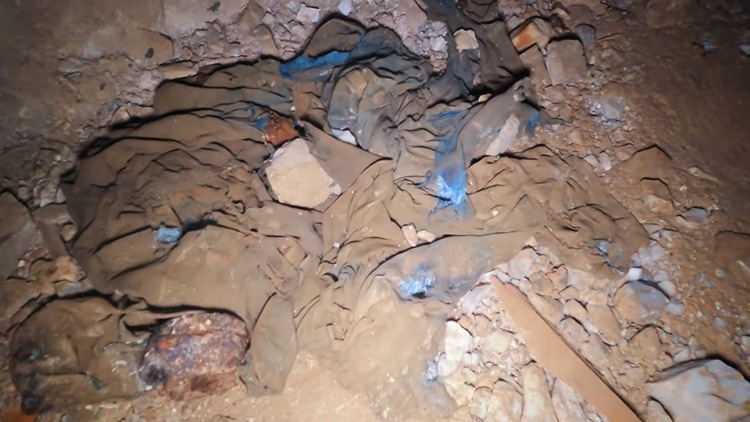The Silver Miners That Left Behind Blue Gold

Virginia City, Nevada, is a small town about half an hour’s drive from the state capital of Carson City. (Here’s a map.) Only about 700 people live in Virginia City today, but a century and a half ago, it was one of the most populous in the region. Per the 1880 census, 10,917 people called Virginia City home that year, constituting nearly 20% of the state’s entire population. The reason? Silver. In 1859, news of the “Comstock Lode” in nearby Mount Davidson spread throughout the region. Over the next two decades, the Virginia City boomtown formed and grew at the mountain’s base as thousands of people flocked into the area in hopes of striking it rich.
Few did, of course; gold and silver rushes tend to make for few big winners — at least in the short term. But with enough patience, you may be able to strike it rich in Virginia City and other, similar places, even if you can’t find any silver in them hills.
Just look for the pants. Specifically, the denim jeans.
Denim jeans have been around since 1873, when a German immigrant named Levi Strauss (yes, as in “Levi’s Jeans”) came up with the idea for a denim-based work pant that gold and silver miners could wear without needing to constantly replace or repair their clothes. A customer of his, a tailor named Jacob Davis, had the idea of adding copper rivets to the pockets and other areas that could easily tear. The two partnered and started selling denim overalls to prospectors throughout the American west, making a fortune of their own without ever having to step into a gold or silver mine. When prospecting gave way to mining corporations, the mining companies ordered the workwear directly from Levi’s, and issued them to miners as part of their work attire. Miners would show up to the mines dressed in whatever they wished, don a pair of denim overalls over their clothes, and go to work.
And sometimes, at the end of the day, those workers would just take off their overalls and leave them behind on the job site. As a result, the Comstock Lode and similar sites may not have a lot of silver left to find, but there is a good amount of antique denim to be discovered — if you’re willing to dig a little. And it may be worth your time to do.
In January of 2019, the Las Vegas Review-Journal spoke with 41-year-old Caden Gould (“a handyman and adventurer dressed in an old pair of Wranglers, flannel shirt and scuffed boots,” per the R-J) and his partner, a 70-year-old antique dealer named Ron Bommarito. The pair explore abandoned mine shafts throughout the region looking for the discarded overalls of miners from a century beforehand. A typical excursion for Gould, per the R-J, involves him “turning on his headband flashlight, [sliding] onto his belly and wiggl[ing] into the tight chasm” that used to be a mine entrance before the rocks above caved it in. The risk is real — Gould told the paper that the initial part of the effort “is where you get killed” if things go wrong. But the payoff is real, too. Collectors in search of a piece of American history from the gold rush time period will pay big money for the parcels Gould and Bommarito find. Per R-J, “a pair of Levi’s denim jeans originally purchased in 1893 by a dry goods store owner in the Arizona Territory sold for nearly $100,000,”
And Gould isn’t alone — at all — in this potentially-lucrative hobby. In September of 2019, a modern-day explorer named Michael Allen Harris sat down with the Guardian to tell his story. Like Gould, Harris and his father-in-law, a geologist, “crawl around wearing hard hats and headlamps. We don’t tunnel underground, just dig through rocks inside the mine opening, but it can be dangerous: we’re crawling around on probably 100 tons of unstable rocks.” And in February of 2022, My Modern Met reported that another explorer, Brent Underwood, “trek[ked] through an old abandoned mine [in California and made] an exciting discovery—a rare pair of 100-year-old jeans.” (A picture of one of Underwood’s discoveries is above.) Harris’ biggest payday was $30,000; the jeans Underwood discovered will likely come close to that amount.
As Harris notes, in most cases, “It’s legal for anyone to go” into the abandoned mines that he and others venture into, but it’s really not a safe hobby, so please, don’t try it unless you know what you’re doing. And either way, don’t bother looking for silver while you’re down there. Almost all of these mines have been picked clean or close enough to that; it’ll cost you more to find the silver than it’s worth. You’re better off focusing on the denim.
Bonus fact: Perhaps the most famous miner working in the Comstock Lode made his fortune another way — through the written word. In 1861, a young man named Samuel Clemens came to Nevada in hopes of finding riches, but ended up striking out in the silver mines; after a year of mining, his wealth totaled $45. He ended up securing a job — $25 a week! — writing and editing for the Virginia City Territorial Enterprise, the largest newspaper in what was then the Nevada Territory. A year later, Clemens’ name no longer appeared in the paper — he instead started writing under the name “Mark Twain,” and launched a legacy that would extend well beyond his lifetime.
From the Archives: The Land Down Under in the Land Down Under: The opal mining boomtown that still exists, minus the opals or direct sunlight.
